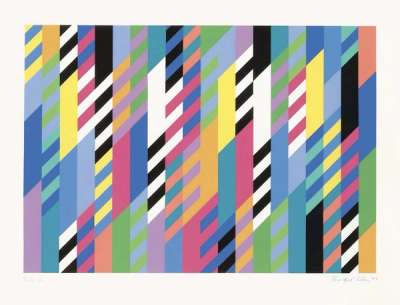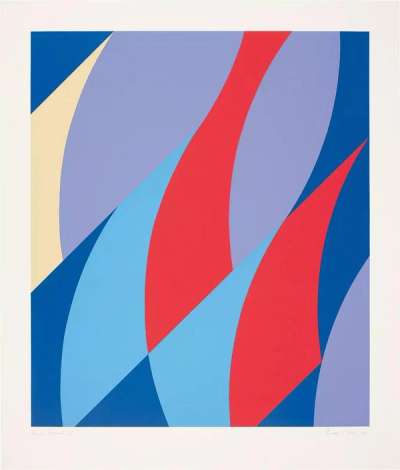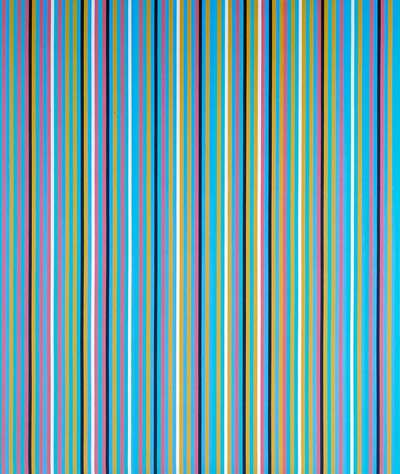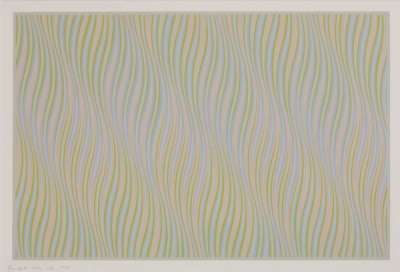 Large Fragment ⓒ Bridget Riley, 2006
Large Fragment ⓒ Bridget Riley, 2006
Interested in buying or selling
Bridget Riley?

Bridget Riley
111 works
Bridget Riley is an acclaimed British painter, best known for her captivating Op Art paintings. Moving between London, Cornwall and Vaucluse in France, Riley has become recognised as a key figure in modern and abstract art.
Read MyArtBroker's Bridget Riley Investment Guide In 2024.
Although Riley was born in London, she moved to Cornwall with her mother and sister at the beginning of World War II. The time Riley spent living near the Cornish seaside played a key role in the development of her artistic style and visual language.
Read this A-Z Guide of Bridget Riley to discover more interesting facts about this pioneering female artist.
A is for AICA Critics Prize
In 1963, Riley was awarded the distinguished AICA Critics Prize from the International Association of Art Critics. This would be the first in a long series of awards for Riley following her first solo exhibition in Gallery One, London, which was organised by art dealer Victor Musgrave in 1962.
B is for Black and White
Riley’s early works are marked by her monochromatic colour palette. The artworks Riley produced in the 1960s are dominated by black and white geometric patterns that produce disorientating effects on the eyes, making it seem as if the static patterns are moving. It wasn’t until 1967 that Riley moved away from black and white paintings and started experimenting with colour.
C is for Cornwall
Riley’s artistic style was heavily influenced by the time the artist spent living in Cornwall during her youth. Riley moved from London to Cornwall during World War II and explains how she was mesmerised by the ever-changing Cornish skies and seas. The visual stimulation aroused by these natural landscapes is something that Riley tries to reproduce in her own artworks.
D is for the De La Warr Pavilion
In July and August 2015, a large retrospective of Riley’s work was organised at the De La Warr Pavilion in Bexhill-on-Sea. The exhibition was called Bridget Riley: The Curve Paintings 1961–2014 and included a selection of over 30 paintings and studies from throughout the artist’s career. The exhibition was focused on Riley’s use of the curve motif and how this developed over the course of the 50 years in which she was active as an artist.
E is for Emotions
Later in Riley’s career, the artist became fascinated with colour and the way in which colours can evoke certain emotional reactions in the viewer. While the artist rose to fame with her black and white paintings in the 1960s, Riley’s later works are marked by her intricate and considered use of colour. Other artists who were interested in the relationship between colour and emotion were Ukrainian-born, French artist Sonia Delaunay and German artist Josef Albers.
F is for France
In 1961, Riley and her partner, Peter Sedgley, visited the Vaucluse plateau in the South of France. The pair fell in love with the region and bought a derelict farm which they transformed into a studio.
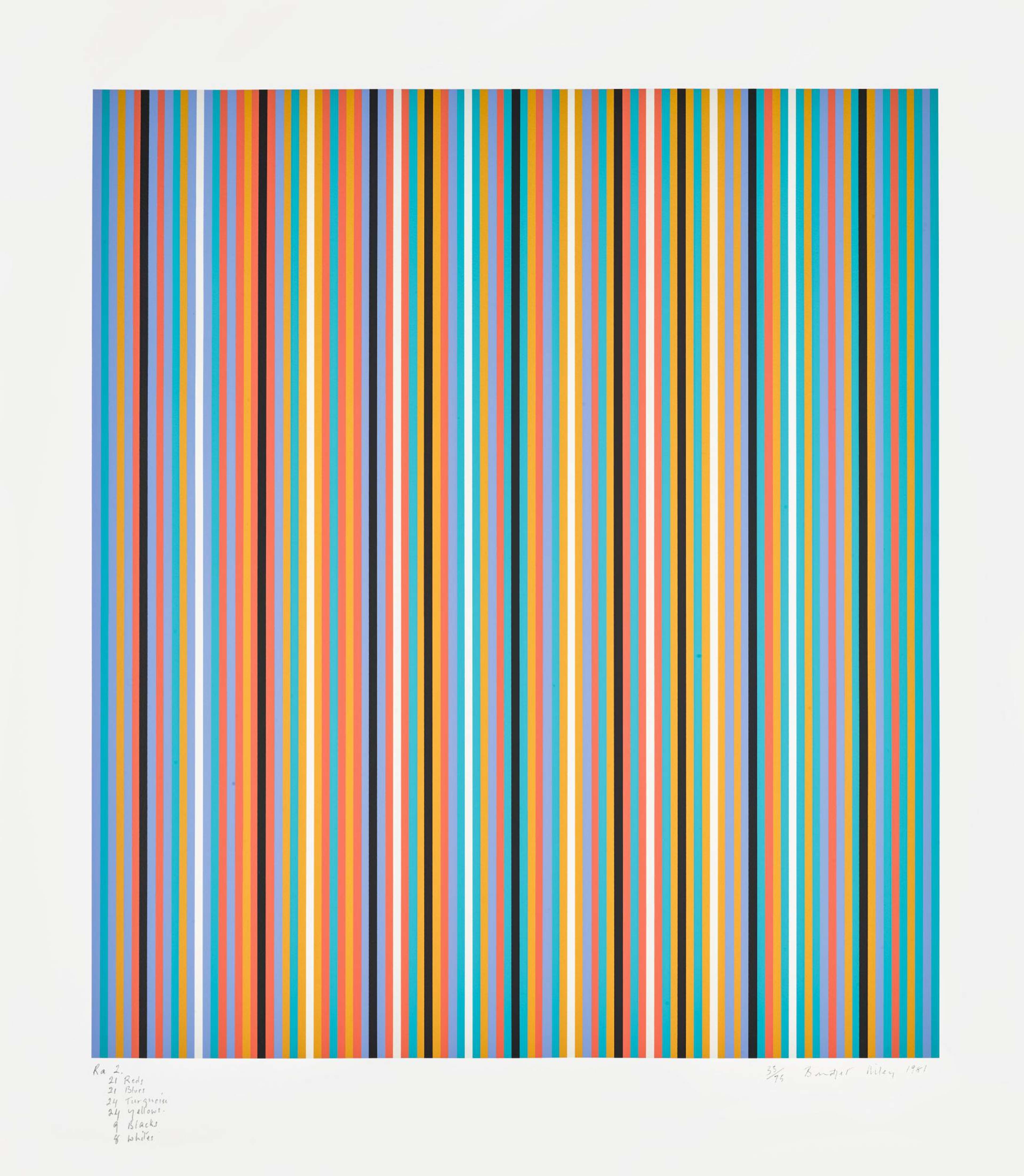 RA2 ⓒ Bridget Riley, 1981
RA2 ⓒ Bridget Riley, 1981G is for Geometric Patterns
Riley’s early works are characterised by her use of geometric shapes which she arranges into visually stimulating patterns. The artist rose to international fame in the 1960s following the exhibition of some of her artworks at the Museum of Modern Art in New York. The Responsive Eye exhibition featured some of her impressive paintings, all of which were rendered in black and white and depicted intricate geometric patterns of shapes that were arranged in such as way as to give the impression that the shapes were flashing, vibrating, and blurring into one another.
H is for Henri Matisse
It is clear that Henri Matisse had a strong influence on the development of Riley’s artistic style. In many of Riley’s artworks, the artist attempts to mimic natural movements such as rolling waves and gusts of winds. To do this, Riley drew on techniques used by Matisse, who was known for both his adventurous use of colour and fluid draughtsmanship. Other artists that inspired Riley were the Italian Futurists and other French artists such as Georges Seurat.
I is for Intervals
Intervals is a collection of artworks that Riley produced late in her artistic career. The collection resonates with Riley’s iconic Stripe prints which the artist started working on in 1971. The artworks in this collection feature simple arrangements of lines which encourage the viewer to look closely at the prints and think about their composition and spatial arrangement. The stability of the repeated stripe form was a means for Riley to explore the visual effects of colour and varying colour combinations in greater depth.
J is for June 2016
June 2016 was an important date for Bridget Riley as one of her artworks, Untitled, Diagonal Curve (1966), sold for £4.3 million at Christies in London, surpassing its estimates of £2.5–3.5 million.
At the time, this sale broke the record for the most expensivve Riley sale at auction, though it has since been surpassed by the sale of Gala at the 2022 Modern British Art Evening Sale in Christie’s in London, which exceeded its presale estimates of £2.5-£3.5million, to sell for an eye-watering £4.4million.
K is for Key Exhibitions
Riley’s exhibitions span throughout her career from 1964 to 2021. The Responsive Eye exhibition at the Museum of Modern Art, New York, in 1964 catapulted the artist onto the international stage. In 1999, the Serpentine held an exhibition surveying Riley’s artworks from the 1960s-1970s, which also included some new works, such as Serpentine (1999), that the artist made for the exhibition itself. More recently, The Hayward Gallery put on a retrospective exhibition of Riley’s work in 2019 which was the largest Riley retrospective seen to date.
L is for Lozenges
Lozenges is a body of work produced between 1998 and 2009 characterised by captivating planes of interlocking colour and geometric forms. This collection of artworks marks a departure from Riley’s strict black and white colour palette and features combinations of bright, carnival colours. The sweeping motion of the curved shapes mimics the undulations of nature such as waves rolling, and trees being blown in the wind.
M is for Movement
Movement features heavily in Riley’s oeuvre and the artist was fascinated by the way in which movement could be conveyed in her artworks. From creating paintings that double as optical illusions to prints that mimic the movements of nature, Riley’s artworks are always dynamic and infused with a feeling of motion.
N is for The National Gallery
As a result of her widespread international recognition and the influence she has had on many great artists, Riley was appointed on the board of directors for the National Gallery in London. In the 1980s, Riley used her position as a board member to successfully block Margaret Thatcher’s plan to give the neighbouring piece of property to developers. As a result of being able to keep the land, the National Gallery was able to expand and develop the museum’s Sainsbury Wing.
O is for Op-Art
Riley has been categorised as an Op artist due to the way in which she explored the interplay of shape, line and light in her works. Op Art, short for ‘optical art’, refers to the way in which artists can use shapes, colours, and patterns to produce images that seem to be moving. Riley’s precise compositions are mesmerising as the shapes appear to vibrate, pulsate, and blur into one another, evoking a strong sense of movement despite being technically static.
P is for Pointillism
As well as producing Op artworks, Riley’s artistic style matured and developed over time as she was exposed to more artists and artistic movements. Riley was clearly influenced by the French Neo-Impressionist artist, Georges Seurat. In particular, Riley was fascinated by Seurat’s pointillism, a technique developed by the French artist which consisted of making paintings out of small, distinct dots of colour which come together in patterns to form an image. In 2015, The Courtauld Gallery organised an exhibition titled Bridget Riley: Learning from Seurat which explored how Riley’s style was influenced by Seurat’s pointillism.
Q is for Queen
In 1974, Queen Elizabeth II gave Riley a Commander of the Most Excellent Order of the British Empire for her outstanding contributions to art and in 1998, Riley became one of only 65 Companions of Honour in Britain. These prestigious accolades capture the significant impact Riley has had on modern, British art. The artist continues to inspire younger generations of artists such as Damien Hirst and Rachel Whiteread.
R is for Royal College of Art
Riley studied at the Royal College of Art from 1952-55 after doing her Bachelor’s at Goldsmiths. Other notable alumni of the Royal College of Art from the 20th and 21st centuries include sculptors Barbara Hepworth and Henry Moore and painters Frank Auerbach and David Hockney. After studying, Riley worked as an art teacher which enabled her to spend time honing her own artistic skills.
S is for SPACE
SPACE stands for Space Provision Artistic Cultural and Educational and in 1968, Riley along with Op artist Peter Sedgley and journalist Peter Townsend, created this organisation in order to provide artists with affordable studio spaces. SPACE is the oldest continuously operating artist studio organisation in London to date and, in addition to providing studio space to artists, SPACE organises exhibitions, international residencies and has a learning and participation platform to support the local community.
T is for Tate Britain
In 2003 the Tate Britain organised a major Riley retrospective, entitled Bridget Riley, which surveyed the artist’s impressive career and included key examples from every phase of her work. The exhibition captured how the artist’s style developed over time, especially the way in which the artist transitioned from monochromatic, black and white paintings to experimenting with bright colours. The exhibition was curated by Paul Moorhouse in close collaboration with Riley.
U is for Untitled (Diagonal Curve) (1966)
Untitled (Diagonal Curve) (1966) is Riley's highest selling artwork. The work is composed of black and white undulations that appear to move in waves across the canvas. The vertiginous assemblage of lines seems to oscillate, imbuing the artwork with a sense of movement. This piece is one of Riley's last experimentations with black and white. In the late 1960s, the artist abandoned her monochromatic palette in favour of bold experimentations with colour.
V is for Venice Biennale
In 1968, Riley represented Great Britain at the Venice Biennale, an international cultural exhibition hosted annually in Venice, Italy. Every year, a number of prizes are awarded, and Riley was the first woman to receive the acclaimed International Painting Prize. Other notable recipients of this award are German painter Max Ernst (1954) and French painter Henri Matisse (1950).
W is for Waves
Waves is a collection of artworks Riley worked on in the 1970s and 1980s. The collection is composed of works which all depict patterns of waved lines which evoke a sense of movement. Unlike the Stripes collection, in which Riley produces works based on vertical and horizontal lines rendered in bright colours, in Waves Riley privileges a selection of mixed hues in order to experiment with tone and how this affects perception.
X is for Bridget Riley x The Viewer
Riley’s artworks have been described as collaborative pieces due to Riley’s incredible ability to draw the viewer into her artworks, captivating them and prompting them to explore the works with curiosity and consideration.
Y is for Years and Years
Born in 1931, Riley has been making art for over 70 years. Over the course of seven decades, the artist has honed her visual style and developed a personal philosophy: that complexity lurks beneath the surface of simplicity, if only we take the time to notice.
 Féte ⓒ Bridget Riley, 1989
Féte ⓒ Bridget Riley, 1989Z is for Zig
Zig, also known as the Rhomboid collection, is a body of artworks produced by Riley in the 1980s and 1990s. The collection captures how the artist began to merge her iconic horizontal stripes from her Stripes collection with short, diagonal elements. Riley’s Stripes collection was marked by harmony and order, whereas the artworks in the Zig collection are more dynamic and complex, as Riley wanted to explore how colours could interact with one another through the use of shapes and their composition.





